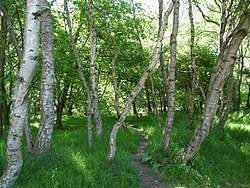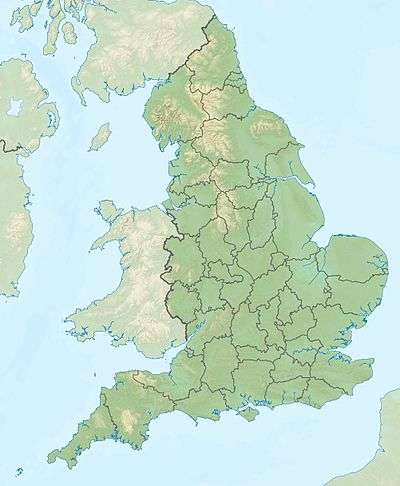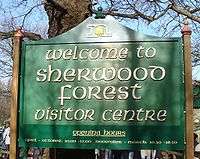Sherwood Forest
Sherwood Forest is a royal forest in Nottinghamshire, England, famous by its historic association with the legend of Robin Hood.
| Sherwood Forest | |
|---|---|
 Birch trees in Sherwood Forest | |
| Map | |
 | |
| Location | Nottinghamshire, England |
| Coordinates | 53°12′16.09″N 1°4′21.94″W |
The area has been wooded since the end of the Last Glacial Period (as attested by pollen sampling cores). Today, Sherwood Forest National Nature Reserve encompasses 423.2 hectares (1,046 acres),[1] surrounding the village of Edwinstowe, the site of Thoresby Hall. It is a remnant of an older, much larger, royal hunting forest, which derived its name from its status as the shire (or sher) wood of Nottinghamshire, which extended into several neighbouring counties (shires), bordered on the west along the River Erewash and the Forest of East Derbyshire. When the Domesday Book was compiled in 1086, the forest covered perhaps a quarter of Nottinghamshire(approximately 19,000 acres or 7,800 hectares) in woodland and heath subject to the forest laws.
Geology
Sherwood Forest is established over an area underlain by the Permian and Triassic age New Red Sandstone. The larger part of the Forest is found across the outcrop of pebbly sandstones known as the Chester Formation. The regional dip is a gentle one to the east, hence younger rocks are found in that direction and older ones exposed to the west. The local stratigraphy is (uppermost/youngest at top):
- Mercia Mudstone Group
- Tarporley Siltstone Formation (siltstones, mudstones and sandstones)
- including Retford Member (mudstones)
- Tarporley Siltstone Formation (siltstones, mudstones and sandstones)
- Sherwood Sandstone Group
- Chester Formation (pebbly sandstones)
- Lenton Sandstone Formation
- Edlington Formation (mudstones and sandstones)[2]
The sandstone is an aquifer providing a local water supply. Quaternary deposits include river sands and gravels, river terrace deposits and some scattered mid-Pleistocene glacial till. There are 41 local geodiversity sites within the Sherwood NCA; these are largely quarries and rivers sections. [3]
Management and conservation
The Sherwood Forest Trust is a small charity that covers the ancient royal boundary and current national character area of Sherwood Forest.[4] Its aims are based on conservation, heritage and communities, but also include tourism and the economy.

Nottinghamshire County Council and the Forestry Commission jointly manage the ancient remnant of forest north of the village of Edwinstowe, providing walks, trails and a host of other activities.[5]
This central core of ancient Sherwood is a Site of Special Scientific Interest (SSSI),[6] NNR,[7] and Special Area of Conservation (SAC).[8] It is a very important site for ancient oaks, wood pasture, invertebrates and fungi, as well as being linked to the legends of Robin Hood.
During the Second World War parts of Sherwood Forest were used extensively by the military for ammunition stores, POW camps and training areas.[9] Oil was produced at Eakring.[10] After the war, large ammunition dumps were abandoned in the forest and were not cleared until 1952, with at least 46,000 tons of ammunition in them.[11]
Part of the forest was opened to the public as a country park in 1969 by Nottinghamshire County Council, which manages a small part of the forest under lease from the Thoresby Estate. In 2002, a portion of Sherwood Forest was designated a National Nature Reserve by English Nature. In 2007, Natural England officially incorporated the Budby South Forest, Nottinghamshire's largest area of dry lowland heath, into the Nature Reserve, nearly doubling its size from 220 to 423 hectares (540 to 1,050 acres).[12]
A new Sherwood Forest Visitor Centre was authorised in 2015. In August 2018, the RSPB opened the new development with a shop and café, after being granted permission to manage the woods in 2015. Part of an agreement with Natural England was that the land where the existing 1970s visitor centre was located would be restored to wood pasture.[13][14][15]
Some portions of the forest retain many very old oaks, especially in the portion known as the Dukeries, south of the town of Worksop, which was so called because it used to contain five ducal residences.
The River Idle, a tributary of the Trent, is formed in Sherwood Forest from the confluence of several minor streams.
Tourism

Sherwood attracts around 350,000 tourists annually, many from other countries.[16] Each August the nature reserve hosts an annual, week-long Robin Hood Festival. This event recreates a medieval atmosphere and features the major characters from the Robin Hood legend. The week's entertainment includes jousters and strolling players, dressed in medieval attire, in addition to a medieval encampment complete with jesters, musicians, rat-catchers, alchemists and fire eaters.
Throughout the year, visitors are attracted to the Sherwood Forest Art and Craft Centre, which is situated in the former coach house and stables of Edwinstowe Hall in the heart of the Forest.[17] The centre contains art studios and a cafe, and hosts special events, including craft demonstrations and exhibitions.
Major Oak
Sherwood Forest is home to the famous Major Oak, which, according to local folklore, was Robin Hood's principal hideout. The oak tree is between 800 and 1,000 years old and, since the Victorian era, its massive limbs have been partially supported by an elaborate system of scaffolding. In February 1998, a local company took cuttings from the Major Oak and began cultivating clones of the famous tree with the intention of sending saplings to be planted in major cities around the world.
The Major Oak was featured on the 2005 BBC TV programme Seven Natural Wonders as one of the natural wonders of the Midlands.
Thynghowe
Thynghowe, an important Danelaw meeting place where people came to resolve disputes and settle issues, was lost to history until its rediscovery in 2005–06 by local history enthusiasts[18] amidst the old oaks of an area known as the Birklands. Experts believe it may also yield clues as to the boundary of the ancient Anglo Saxon kingdoms of Mercia and Northumbria.
English Heritage had inspected the site, and have confirmed it was known as "Thynghowe" in 1334 and 1609.[19][20]
See also
- List of forests in the United Kingdom
- List of ancient woods in England
- Sherwood Foresters, a British Army regiment associated with Nottinghamshire
References
- "Sherwood Forest NNR". Natural England. Retrieved 17 March 2013.
- "GeoIndex Onshore". British Geological Survey. Retrieved 2 July 2020.
- "NCA profile 49. Sherwood". Natural England. Retrieved 2 July 2020.
- "Home - The Sherwood Forest Trust Nottinghamshire". The Sherwood Forest Trust Nottinghamshire.
- "Sherwood Forest". nottinghamshire.gov.uk.
- "Magic Map Application". defra.gov.uk.
- "Nottinghamshire's National Nature Reserve". naturalengland.org.uk.
- "Birklands and Bilhaugh". defra.gov.uk.
- "Sherwood Forest in World War II". mercian-as.co.uk. Retrieved 16 May 2019.
- Levine, Joshua (2015). The Secret History of the Blitz. London: Simon & Schuster. pp. 117–130. ISBN 978-1-4711-3102-8.
- "Ammunition, Sherwood Forest: 21 Mar 1950: House of Commons debates". TheyWorkForYou. Retrieved 16 May 2019.
- "Sherwood Forest to double in size". BBC News. 21 March 2007. Retrieved 17 March 2013.
- RSPB chosen to build Nottinghamshire's Sherwood Forest visitor centre BBC News Nottingham, 12 August 2015. Retrieved 3 June 2020
- Sherwood Forest project: Plans for £5.3m visitor centre unveiled BBC News Nottingham, 19 March 2016. Retrieved 3 June 2020
- "New Sherwood Forest visitor centre opens". BBC News. 27 August 2018. Retrieved 29 April 2019.
- "New £5m Sherwood Forest centre opens". 27 August 2018.
- "Sherwood Forest Art and Craft Centre". Archived from the original on 29 October 2007.
- Richard Moss (25 April 2008). "Amateur Archaeologists Find Ancient 'Thyng' In Sherwood Forest". Culture24. Retrieved 17 March 2013.
- "Thynhowe". english Heritage. Archived from the original on 27 July 2011. Retrieved 17 March 2013.
- New £5m Sherwood Forest visitor centre opens BBC News Nottingham, 27 August 2018 Retrieved 3 June 2020
Further reading
- Bankes, Richard. Sherwood Forest in 1609: A Crown Survey (Thoroton Society record series)
- Conduit, Brian. Exploring Sherwood Forest
- Fletcher, John. Ornament of Sherwood Forest From Ducal Estate to Public Park
- Gray, Adrian. Sherwood Forest and the Dukeries (Phillimore) 2008
- Sherwood Forest and the East Midlands Walks (Jarrold Pathfinder Guides)
- Innes-Smith, Robert. The Dukeries & Sherwood Forest
- Ottewell, David. Sherwood Forest in Old Photographs (Britain in Old Photographs)
External links
| Wikimedia Commons has media related to Sherwood Forest. |
| Wikivoyage has a travel guide for Sherwood Forest. |
- . Encyclopædia Britannica. 24 (11th ed.). 1911. p. 853.
- Forestry Commission
- The News, History, and Archaeology of The Real Sherwood Forest
- Nottinghamshire County Council's Official Sherwood Forest Page
- Sherwood Forest Regeneration Plans
- Sherwood Forest Trust Official Website
- The Living Legend details current plans for the forest.
- Official tourism website for Nottinghamshire and Sherwood Forest
- According to Ancient Custom: Research on the possible Origins and Purpose of Thynghowe Sherwood Forest